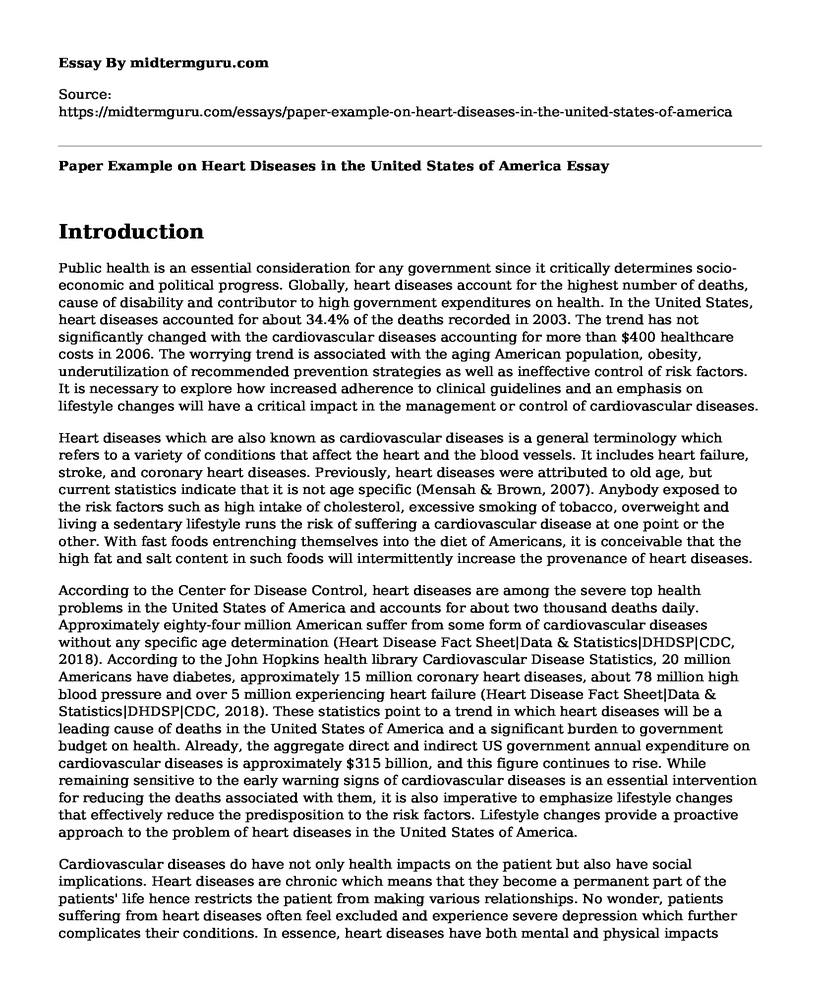Introduction
Public health is an essential consideration for any government since it critically determines socio-economic and political progress. Globally, heart diseases account for the highest number of deaths, cause of disability and contributor to high government expenditures on health. In the United States, heart diseases accounted for about 34.4% of the deaths recorded in 2003. The trend has not significantly changed with the cardiovascular diseases accounting for more than $400 healthcare costs in 2006. The worrying trend is associated with the aging American population, obesity, underutilization of recommended prevention strategies as well as ineffective control of risk factors. It is necessary to explore how increased adherence to clinical guidelines and an emphasis on lifestyle changes will have a critical impact in the management or control of cardiovascular diseases.
Heart diseases which are also known as cardiovascular diseases is a general terminology which refers to a variety of conditions that affect the heart and the blood vessels. It includes heart failure, stroke, and coronary heart diseases. Previously, heart diseases were attributed to old age, but current statistics indicate that it is not age specific (Mensah & Brown, 2007). Anybody exposed to the risk factors such as high intake of cholesterol, excessive smoking of tobacco, overweight and living a sedentary lifestyle runs the risk of suffering a cardiovascular disease at one point or the other. With fast foods entrenching themselves into the diet of Americans, it is conceivable that the high fat and salt content in such foods will intermittently increase the provenance of heart diseases.
According to the Center for Disease Control, heart diseases are among the severe top health problems in the United States of America and accounts for about two thousand deaths daily. Approximately eighty-four million American suffer from some form of cardiovascular diseases without any specific age determination (Heart Disease Fact Sheet|Data & Statistics|DHDSP|CDC, 2018). According to the John Hopkins health library Cardiovascular Disease Statistics, 20 million Americans have diabetes, approximately 15 million coronary heart diseases, about 78 million high blood pressure and over 5 million experiencing heart failure (Heart Disease Fact Sheet|Data & Statistics|DHDSP|CDC, 2018). These statistics point to a trend in which heart diseases will be a leading cause of deaths in the United States of America and a significant burden to government budget on health. Already, the aggregate direct and indirect US government annual expenditure on cardiovascular diseases is approximately $315 billion, and this figure continues to rise. While remaining sensitive to the early warning signs of cardiovascular diseases is an essential intervention for reducing the deaths associated with them, it is also imperative to emphasize lifestyle changes that effectively reduce the predisposition to the risk factors. Lifestyle changes provide a proactive approach to the problem of heart diseases in the United States of America.
Cardiovascular diseases do have not only health impacts on the patient but also have social implications. Heart diseases are chronic which means that they become a permanent part of the patients' life hence restricts the patient from making various relationships. No wonder, patients suffering from heart diseases often feel excluded and experience severe depression which further complicates their conditions. In essence, heart diseases have both mental and physical impacts which weigh a toll on patient health is thus increasing their likelihood of dying early (Mensah & Brown, 2007). Even though the risk factors such as high blood pressure cause the high cases of cardiovascular-associated deaths, higher cholesterol levels, obesity, and inadequate exercise dramatically increase the risk of developing such conditions. Therefore, it is necessary to contextualize the problem of heart diseases within the realms of lifestyle changes including taking diets low in cholesterol, fats and salts, and regular exercise as major interventions for better outcomes.
Conclusion
Various studies have documented dramatic reductions in age-adjusted mortalities resulting from heart diseases, stroke, and aggregate cardiovascular diseases. There is also declines in the mean population blood pressure and cholesterol levels. An increase in the aging American population, binge smoking and blatant refusal to adhere to proper lifestyle practices imply the need for not only a medical approach to the problem of cardiovascular diseases but also a psychological intervention that seeks to drastically change the perspectives of the population towards healthy lifestyle practices. Without a multidimensional approach to the problem of heart diseases in the United States of America, it is highly probable that the prevalence will remain high implying an increased cost of care and more deaths recorded. It is important to note that lifestyle changes compounded with other primordial, primary and secondary preventions can substantially address the epidemic of cardiovascular diseases In the United States (Mensah & Brown, 2007). However, these approaches remain to be sub-optimally exploited hence reduced survival and quality of life. Adherence to medical and lifestyle guidelines would guarantee effective prevention and control and an overall rise in expectancy.
References
Heart Disease Fact Sheet|Data & Statistics|DHDSP|CDC. (2018). Retrieved from https://www.cdc.gov/dhdsp/data_statistics/fact_sheets/fs_heart_disease.htm
Mensah, G. A., & Brown, D. W. (2007). An overview of cardiovascular disease burden in the United States. Health Affairs, 26(1), 38-48.
Cite this page
Paper Example on Heart Diseases in the United States of America. (2022, Sep 14). Retrieved from https://midtermguru.com/essays/paper-example-on-heart-diseases-in-the-united-states-of-america
If you are the original author of this essay and no longer wish to have it published on the midtermguru.com website, please click below to request its removal:
- Paper Example on Public Health: The Problem of Dehydration
- Strengths and Weaknesses of the Articles: Workplace Health Promotion
- Paper Example on Nursing: Servant Leadership Model
- What Are the Consequences of Obesity? - Essay Sample
- Maximizing Professional & Personal Effectiveness for Healthcare Practitioners - Essay Sample
- Jean Watson: Nursing Theorist and Impact on Care Quality - Essay Sample
- Automation in Hospitality & Tourism: How Technology is Transforming the Industry - Essay Sample







